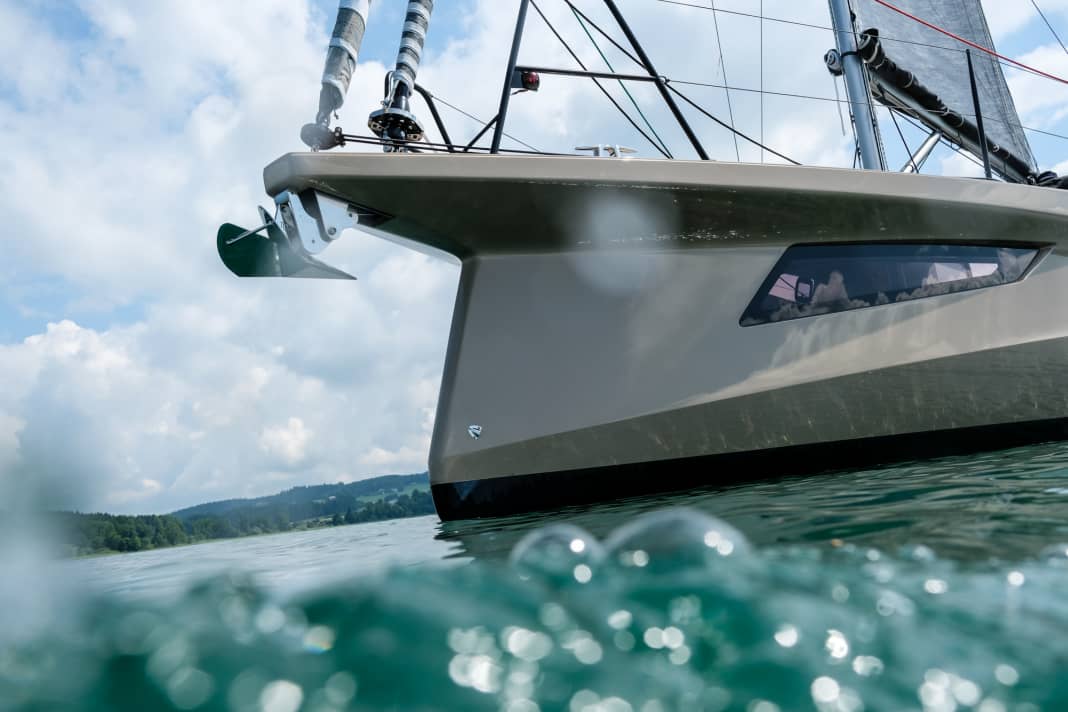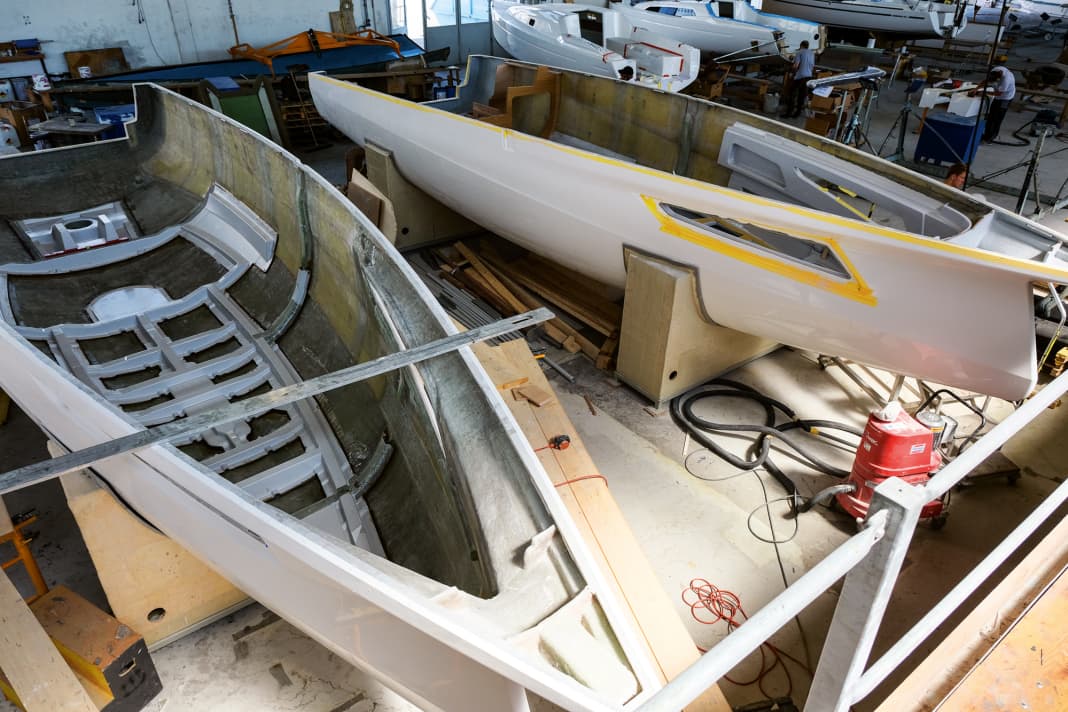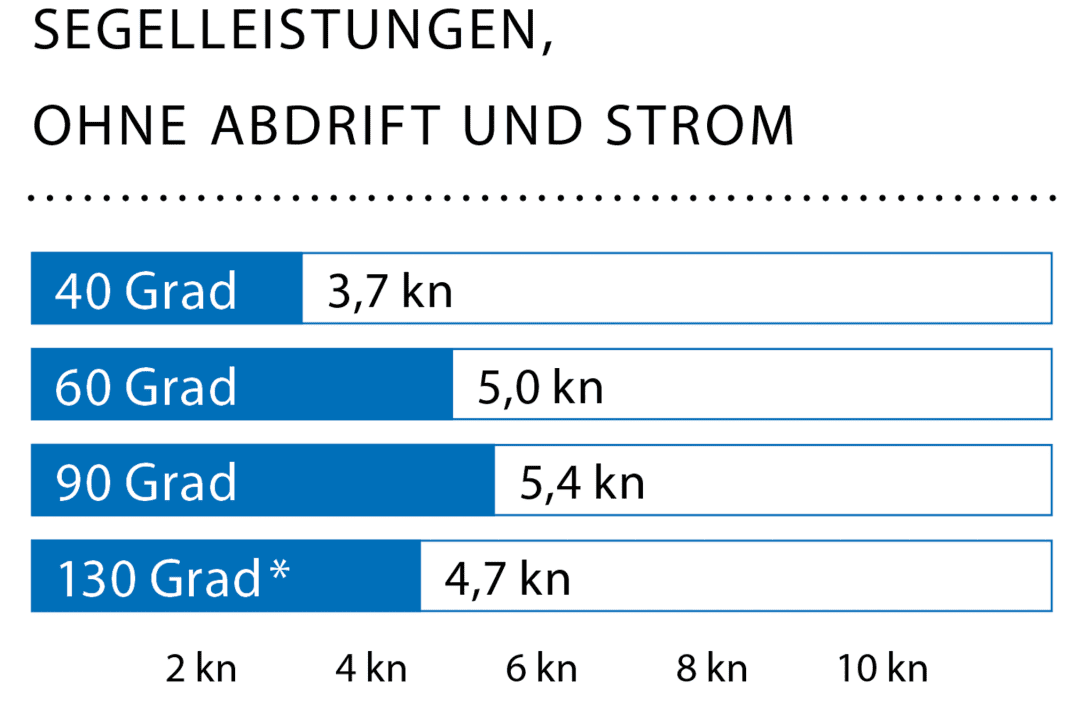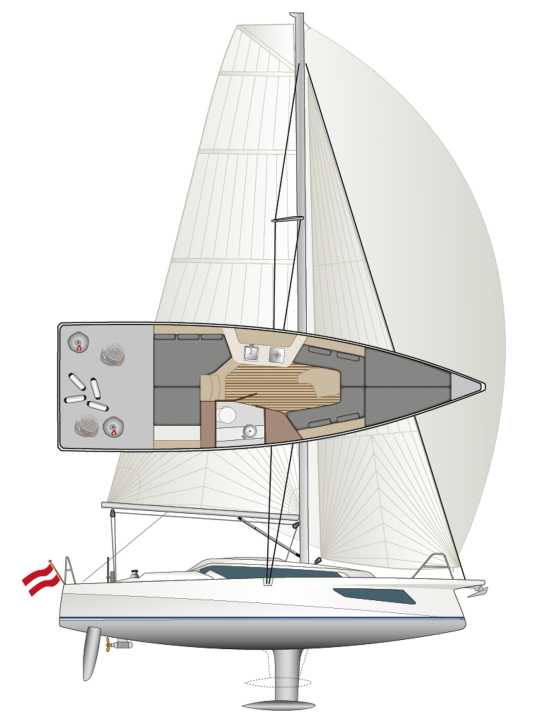





Is this the future?
The rhetorical trick worked: "Are you brave or are you very brave?" asked industrial designer Gerald Kiska from nearby Salzburg, who had been commissioned by the bosses of the Sunbeam shipyard. The Schöchls' answer to this challenging question is self-evident, especially when it is directed at a shipyard management that is in the middle of the second generational change in the company's 70-year history and must therefore be open to fresh thinking per se. Andreas Schöchl is the new man at the helm, son of technical director Manfred, who took over his parents' business together with his cousin Gerhard in 1990.
The result of the generational change and the fruitful collaboration between Kiska, the Slovenian designers Jakopin & Jakopin and the Schöchls floats, sails and does what it is supposed to do: polarise. This is not so much due to the Caffè Latte paintwork, but rather the design language alone. It is not only characterised by chamfers, angles and joints, as is now familiar from the cruising boat segment, but is also downright avant-garde. This starts with the wave piercer bow, which has a strongly negative curve and slopes upwards towards the stern - only to shoot forwards again with a fixed bowsprit. The deck is also wider at the front than the hull underneath; they call it a flight deck, an implied aircraft carrier shape. Bold, fresh, cool.
A fine diagonal chine runs aft, above which the freeboard is slightly retracted. The aggressive design language is complemented by long hull windows in the foredeck, which consist of unequal trapezoids and can be seen on various motorboats.
The competition of the Sunbeam 32.1





Successful provocation
Above the superstructure is a moulded part that conceals the catches and other technical elements and tapers into a U at the front. The cover looks like an X from above, they call it the X-brace. A fold-away cushion can be secured in this brace on the foredeck. And the lid over the deck superstructure is designed to provide thermal insulation and reduce the interior heat through ventilation. The flight deck and X-Brace together create a "second experience zone" alongside the cockpit, as Gerald Kiska calls it. The crew can use the wide foredeck for sunbathing and relaxing, and it is also easier to walk on, which is convenient when walking across the bow.
These things follow an approach to the boat that is fundamental to its creators. It should not offer sailing pleasure to one person, traditionally the skipper, for a few hours, but to the whole family for the entire day. The new boat should be a piece of sports equipment, a floating home and a beach club all in one and, incidentally, "people should look behind it when such a boat leaves the harbour or sails past," muses Kiska with a smile, who bemoans the monotony of sailing yacht design: "When I looked at 20 sailing yachts at the trade fair, by the evening I no longer knew which one looked like what." Kiska attests that the motorboat scene, to which he is connected through his work for the Austrian Frauscher shipyard, is much more progressive. He knows how to defend his provocatively polarising design: "Things that are perceived as beautiful from the outset are bland after six months." But those that polarise find their target group and are more sustainable.
The boat as a beach club
A boat as a fun pontoon? It works like this: The crew anchors using a harness that can be steered from the stern and stretches a sun tent behind it next to the folding bimini (which can also remain up when sailing). This is done with two robust carbon poles that sit in the same fittings. A wide tarpaulin can be rigged between the tops of the poles, rising towards the stern, as you want to be able to stand when jumping into the water. To optimise the usable outside area, the crew electrically extends a bathing platform that is more or less in line with the cockpit and effectively extends it aft. Heavy-duty extensions support the two metre wide and 80 centimetre deep surface, which makes a very robust impression.
When extended, the cockpit is the size of the cockpit of a 40-footer. The benches alone, which are surrounded by a high and ergonomically well-shaped coaming, are an impressive 1.80 metres long. Naturally, there is also a fold-out table with a large compartment as well as outside boxes and various indirect lighting. And with the aforementioned lounger on the foredeck, the crew can spread out on deck to suit their taste and occupation.
Any fun and play equipment for inflating, diving, fishing and bathing can be stored in two large lockers. It's just a shame that the one on the port side is only accessible from the interior.
The boat as a piece of sports equipment
The Sunbeam 32.1 is hardly inferior to its aggressive appearance in terms of sailing characteristics. Well, it's not a racer, and at 4.15 tonnes (weighed according to the shipyard) it's a little too heavy for that, because it's conventionally built from foam sandwich with glass fibre laminate. However, equipped with a decent sail area of 56 square metres on the wind, the J&J design achieves a (dimensionless) sail load factor of 4.7, which makes the boat a moderate performance cruiser according to this indicator.
The T-shaped bomb keel with a depth of 1.80 metres is also still restrained, and the ballast ratio of 30 percent is no indication of a racer - which was not the intention. Andreas Schöchl: "The Sunbeam 32.1 should fulfil many wishes and offer great versatility. And because it does that, it is difficult to categorise."
It is a revolution for the shipyard, which used to develop boats step by step based on its own experience and feedback from customers and sales partners; just one of several innovations from the traditional company. The third generation of boat builders is now focussing on a lower vertical range of manufacture. Whereas in the past they even built cleats and handrails themselves, they now use many suppliers, each of whom are recognised experts in their field and are subject to strict quality controls. The furniture comes from a local cabinetmaker, while the hulls of the 32.1 come from Poland, where the greatest expertise in GRP boatbuilding is based and from where various shipyards source their semi-finished products. In Mattsee, on the other hand, the first and final work steps take place, where the boats are designed and completed.
Backstay is obsolete on the Sunbeam 32.1
Yes, the new Sunbeam is a small revolution, as the test on Lake Mattsee in the Austrian province of Salzburg shows. The jetty of the busy Mattsee Sailing Club is lined with Sunbeams, old and new 22s, an Esse and an Elan. The 32.1 catches the eye almost painfully with its otherness, causing every visitor to pause for an unusually long time, some pulling out their phones to take photos.
Let's go. The fathead mainsail made of optional raised cloth (flex/dimension polyant) from Doyle Raudaschl is set electrically over a Harken 40. The double spreaders from rig manufacturer Z-Spars sweep aft by around 26 degrees, making a backstay obsolete; forestay tension is created by the pull of the upper shrouds. This works well and has proved its worth on smaller yachts, but also on much larger yachts. The mainsheet is designed as a German cupper system without traveller and runs aft through the coaming on both sides to the winches in front of the two wheels, which also operate the halyards and outhauls. Sufficiently large stowage pockets under the side helmsman's seats prevent tangled lines - if you are prepared to tidy up in between.
The genoa is furled using a flat deck furler from Facnor. The sheets run aft on their own winches on the coaming. This is okay, but it is out of the helmsman's reach. Unfortunately, the genoa sheets cannot be laid aft on the winches either, as this would generate overruns. This could be remedied with a further deflection and the boat would be perfectly suitable for single-handed sailing.
Constant width to maximise living space on deck
A pleasure, on the other hand: steering and sailing. From as little as 4 knots of wind, the boat develops pressure, a light attitude and some speed. In the lower wind range, the Sunbeam 32.1 manages to keep up with the wind speed and, thanks to the narrow sheet angle, also reaches good heights. Doyle Raudaschl's sails, which are very stable and easy to trim, certainly helped in the test.
The boat is equipped with two 80-centimetre-diameter wheels that move two blades that are positioned quite far outwards via the outstandingly slip-free, direct and space-saving traveller system from Danish manufacturer Jefa. Only one and a quarter turns are required from stop to stop. Tiller control is not provided.
The two-blade configuration will keep the new yacht effectively under control even at higher angles of bank and is "a must for this hull width", says designer Jernej Jakopin, who also designed the other Sunbeam types in the programme. The Slovenian continues on his design: "The stability is high thanks to the three metre hull width and the keel with its pronounced bulb. The width remains constant all the way to the stern to maximise the living space on deck." The wider aft frames only dip under water and provide more stability when the boat is in position. The bow is also very full, which prevents it from dipping when the boat is in position, which means that the longitudinal axis remains in line with the direction of travel, reducing or even eliminating drift.
The ship needs to be driven
With the narrow rudder blades, the boat steers quite sensitively, but will not overtax anyone who likes to sit at the wheel. The latter works well, by the way, and without a backstay cockpit, the space there is not cramped, which is the case on many boats.
Two rudder blades have a reputation for poor manoeuvrability. In fact, the Sunbeam 32.1 cannot be steered immediately from a standing start, it needs some speed in the ship, as with other boats with double blades. A bow thruster can be found on the options list for optimum support.
The Aquamot e-drive installed on the test boat with 8 kilowatts of power and a 48-volt battery bank with 10 kilowatt hours is also listed there for an additional charge. The drive is impressive with plenty of thrust from a standstill, quiet running and a cruising speed of 5.8 knots, with a maximum of 6.4 knots. The shipyard estimates a range of just under 15 nautical miles at a speed of almost six knots. The engine is designed as a pod and sits under the ship instead of the saildrive. The heavy battery bank from Mastervolt is installed where the combustion engine would normally be, accessible from above in the cockpit. And this is in a suitable location that correlates with the third main use of the boat.
The boat as a floating home
Whether electric or combustion - the drive and fuel tank are located far aft, outside the cabin, as on many catamarans. This is attractive and very welcome, because odours and noise are kept outside and, even more importantly, because the space in the living area can be better divided up and used. "Now it's no longer the engine that lives aft, but a person," explains Andreas Schöchl, pointing to a large transverse bunk behind the open companionway.
"Open" also describes the rest of the interior, which mixes the living, cooking and sleeping areas. There is no door, apart from the one to the wet room. In combination with the extremely large hull windows at the front, the superstructure windows, the front window and a forward hatch, this creates a positive feeling of space, light, air, space and visual generosity. The surfaces of the upholstery, panelling and interior headliner in various subtle shades of grey also contribute to this. Alternatives in light-coloured wood veneer are in the works.
The beautifully integrated galley block consists of an upper cabinet and a lower section containing an induction hob, washbasin and refrigerator as well as additional storage space in robust drawers. This will be sufficient for using the boat as a daysailer or at the weekend.
Two adults and two children can sleep well on board: the aft berth is 1.77 metres wide at shoulder height, and the forward berth, which is created with a transverse cushion on the lower saloon sofas, is still 1.40 metres wide. Indirect lighting in the ceiling, above the upholstery and in the footwell creates a beautiful ambient illumination, while spotlights provide additional functional lighting. Gerald Kiska, friend of drastic descriptions: "This is not a torture chamber that you have to enter, but a room that you want to enter." You might agree.
The only partitioned space is installed on the starboard side, a dedicated wet room with toilet, washbasin and even a shower. The headroom there is 1.77 metres.
The "unschubladisable"
An individual, versatile, modern boat that is a lot of fun, without question. On the way there, it gets a little bitter if money is an issue: 260,610 euros are on the price tag. With upmarket sailing equipment, as on the test boat, there is another surcharge. And then you would probably like to have an autopilot, a folding prop, a heater ...
The 32.1 from Mattsee is not alone in the category of special production boats when it comes to price. The new Dufour 32 from the large series, which also focuses strongly on fun and multiple uses and costs only half as much, may serve as competition in some areas. Another interesting alternative is a J/99 from France, a designated cruiser/racer, but as such also blessed with outstanding sailing characteristics and similarly minimalist equipment.
Or as shipyard senior Manfred Schöchl puts it: "These boats are so expensive, you not only have to ask the wife for permission, you also have to ask the dog!" In this respect, it is fitting that the Sunbeam 32.1 is not just aimed at the skipper, but at the whole family.
Sunbeam 32.1 creates the conceptual triathlon
Beach club, sports equipment, floating home - the new boat from Mattsee creates a conceptual triathlon and thus fulfils the desire of its creators to offer an ideal boat not just for sailing, but for multiple uses. Added to this are a certain coolness factor, individuality and modernity, not to mention a technically high-quality design.
All in all, the Sunbeam 32.1 is what Andreas Schöchl calls the "unclassifiable" yacht. This was also evident in the election for European Yacht of the Year 2022 - where she made it into the circle of nominated yachts - in the Special Yachts group. She simply could not be categorised.
Sunbeam Yachts - For the sea and the sea



Sunbeam Yachts builds high-quality boats from 22 to 32 feet in the centre of the inland, 40 feet plus are planned
The shipyard, which emerged in 1950 from a joinery founded by the Schöchl family in 1838, currently builds the types 22.1, 28.1 and 32.1 at the Mattsee site. The Type 29.1 was also presented at the Düsseldorf boat show in 2024. The shipyard has always focussed on functionality, aesthetics, sportiness and quality. The combination won the European Yacht of the Year title twice with the 34.1 in 2008 and the 46.1 in 2019. The Sunbeam 32.1 was also nominated for the award in 2022.
The measured values for testing the Sunbeam 32.1






The Sunbeam 32.1 in detail

Technical data of the Sunbeam 32.1
- Designer: Jakopin & Jakopin
- CE design category: B
- Torso length: 9,90 m
- Total length: 9,98 m
- Waterline length: 8,86 m
- Width: 2,98 m
- Draught/alternative: 1,80/1,30 m
- Theoretical torso speed: 7.0 kn
- Weight: 4,15 t
- Ballast/proportion: 1,25 t/30 %
- Mast height above waterline: 14,73 m
- Mainsail (Std.): 36,0 m2
- Self-tacking jib (Std.): 20,0 m2
- Machine (Volvo): 13 kW/18 hp
- Fuel tank (plastic): 60 l
- Fresh water tank (plastic): 80 l
- Holding tank (Niro): 60 l
Hull and deck construction
GRP sandwich with foam core, hand lay-up method. Bulkheads glued on and angle laminate. Deck-hull connection screwed and glued
Equipment and prices
- Base price ex shipyard: 260,610 € gross incl. 19 % VAT.
- Standard equipment included: Engine, sheets, railing, navigation lights, battery, compass, cushions, galley/cooker, bilge pump, toilet, fenders, mooring lines, fire extinguisher, electric coolbox, holding tank with suction, antifouling paint
Also included in the price: Anchor windlass, tube kicker, spring cleats, shore connection, log, plumb bob, wind measuring system, pressurised water
- Guarantee/against osmosis: 2/5 years
As of 01/2024. How the prices shown are defined can be found here!
Shipyard
Sunbeam Watersports, 5163 Mattsee, Austria; www.sunbeam-yachts.com
Distribution
Dealer network
YACHT review of the Sunbeam 32.1
Sports equipment, beach club, weekender, cruising boat: the new Sunbeam 32.1 can do many things, sails exceptionally well and is visually unmistakable. The exterior lines are just as polarising as the interior design with the open saloon
Design and concept
- + Independent optics
- + Large cockpit plus bathing platform
- - Only partially suitable for one-handed use
Sailing performance and trim
- + Easily accessible high potential
- + Agile even in light winds
- + Well-functioning controls
Living and finishing quality
- + Motor outside the living area
- + Separate wet room with shower
- + Maximum utilisation of the deck area
Equipment and technology
- + Upscale basic equipment
- + E-drive possible ex shipyard
- - Bb baking box only accessible from the inside
The Sunbeam 32.1 in video
This article first appeared in YACHT 17/2021 and has been updated for this online version.

